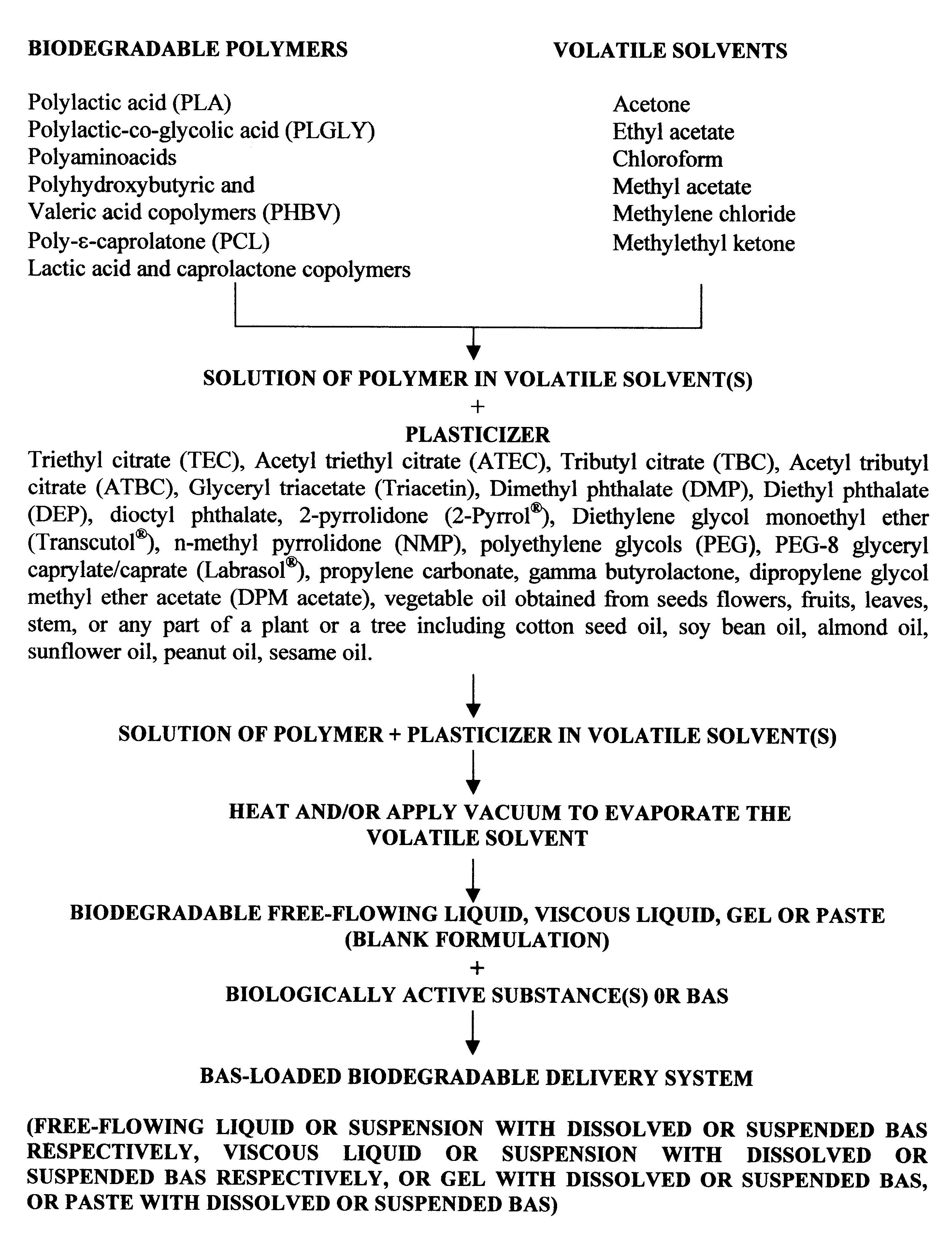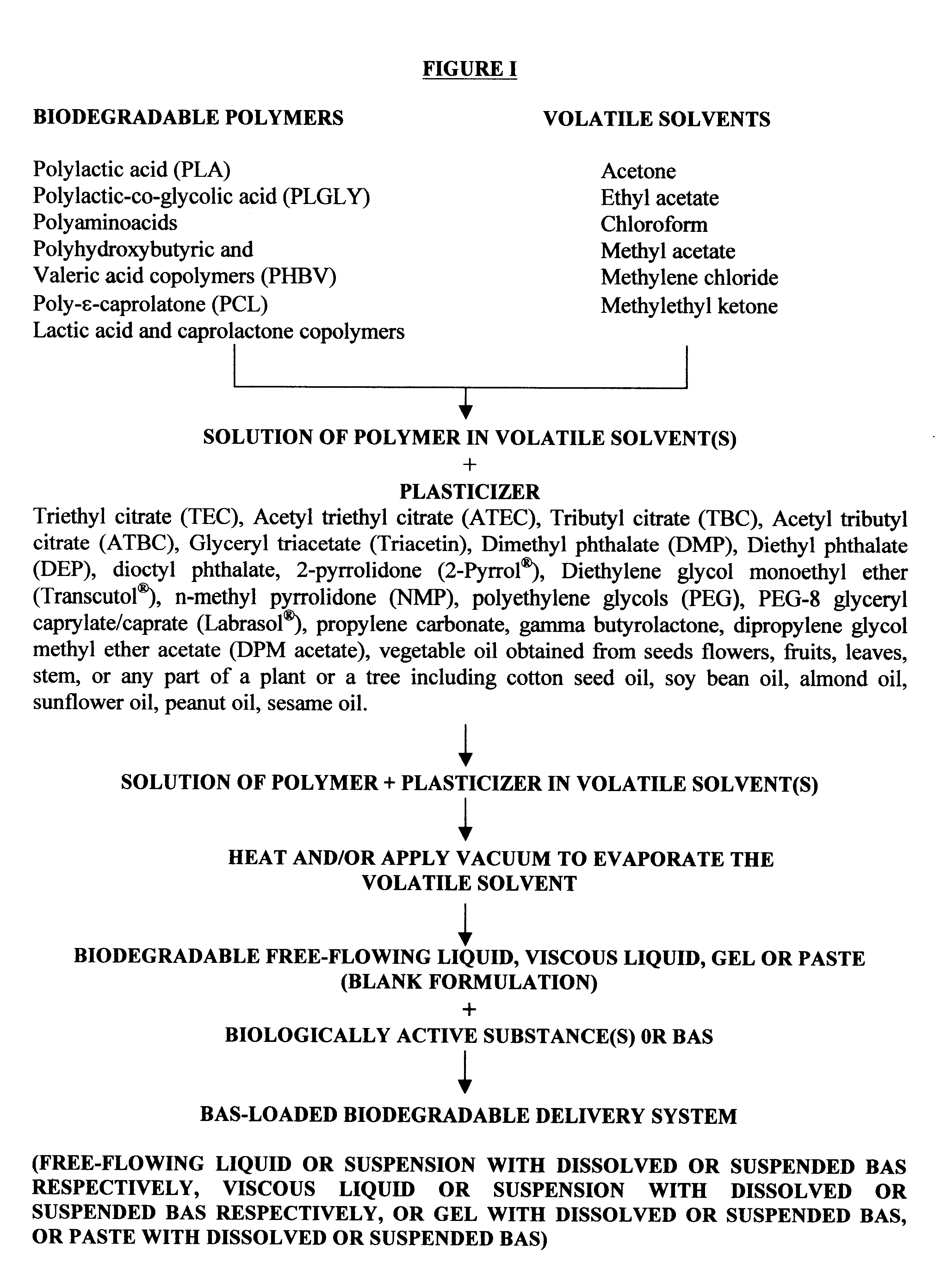The method of the present invention involves dissolving one or more biodegradable polymers and one or more plasticizers in a volatile solvent or mixture of
volatile solvents. The BAS may then be added to this mixture. The volatile solvent is then removed using vacuum or evaporated at an elevated temperature, or removed using both vacuum and elevated temperature. The resulting BAS-loaded formulation provides
controlled release of the biologically active substance over the desired length of time. Alternatively, a blank formulation may be first prepared by the aforementioned method without incorporating the BAS in the formulation. Appropriate quantities of one or more BAS are then added to this formulation to form a BAS-loaded formulation which controls the release of the BAS over the desired length of time.
According to the present invention, the term
polymer includes
oligomer,
copolymer and terpolymer. Biodegradable polymers are used in this invention because they form matrices that can control the release of BAS over a desired length of time, can degrade
in vivo into non-toxic degradation products, and are available in varying physicochemical properties including varying hydrophilicity and hydrophobicity, varying
crystallinity and amorphous states, and varying
solubility in solvents. Moreover, tailoring the release charactertics of the BAS from the biodegradable delivery systems, varying the consistency or
rheology of the matrix formulation, and fabrication of the
system with and without BAS can be easily achieved using this invention.
The present invention relates to the use of BAS-loaded delivery systems for obtaining
controlled release of the BAS over the desired length of time. The resulting delivery systems may be free-flowing or viscous liquids or gels or pastes wherein the BAS is completely dissolved in the
polymer-
plasticizer blended liquids. The delivery systems could also be free-flowing or viscous suspensions wherein the BAS is suspended in the free-flowing or viscous polymer-
plasticizer blended liquids, or gels with dissolved or suspended BAS, or pastes with dissolved or suspended BAS. The consistency or
rheology, physicochemical properties,
physical form of the biodegradable
delivery system (i.e. a solution in which the BAS is completely dissolved or a suspension where the BAS is suspended in the
delivery system), rate and duration of in vivo
biodegradation, and BAS release characteristics depend on a number of factors. These include: physicochemical properties of polymers such as type, molecular weight, glass-
transition temperature, hydrophilicity and
lipophilicity, concentration of the polymer; physicochemical properties of plasticizer such as type, hydrophilicity and
lipophilicity,
boiling point or
melting point; and physicochemical properties of BAS such as type, hydrophilicity and
lipophilicity, molecular weight,
melting point or
boiling point. In addition, the physicochemical interactions between the polymer, plasticizer and BAS also affect the rate and duration of in vivo
biodegradation, and BAS release characteristics. For example, using the present invention, it is possible to tailor the release of a BAS (with specific physicochemical properties and the desired in vivo concentration), for the desired length time. This is achieved by blending an appropriately selected polymer with an appropriately selected plasticizer or mixtures of plasticizers. Besides controlling the release charactertistics of the BAS from the delivery
system described in the present invention, an appropriate blend of the polymer and plasticizer also controls the consistency and rheology of the delivery
system. It is also possible to extend the in vivo duration of stay of the delivery system by selecting a higher molecular weight polymer, since polymers with higher molecular weights generally degrade slowly in the body.
The blank formulation without a BAS may be used as a biodegradable tissue or cavity filler or spacer in the body, whereas, BAS-loaded biodegradable delivery system may be used for the treatment of a variety of diseases and
pathological conditions. The composition of the invention may be injected, implanted or applied in animals and humans. For example, the biodegradable delivery system loaded with an antitumor agent can be directly injected into a
solid tumor or implanted in the brain, thus affording site-specific delivery for
disease states that are otherwise very difficult, if not impossible to treat using the conventional methods of treatment. The system could be loaded with a contraceptive agent,
antipsychotic agent, anticonvulsants, antimalarial, antihypertensive agent,
antibiotics, antiviral agents, and biologically
active protein and peptides, and injected subcutaneously or intramuscularly to provide a controlled release of the agents for the desired length of time. Drugs such as antiinflammatory agents, analgesics and anesthetics could be injected directly into joints or sites in the body from where the pain is emanating, thus providing relief from the excruciating pain and making the joints more mobile. Antigens may also be incorporated into the delivery system and injected, implanted or applied in animals or humans to induce the production of specific antibodies.
 Login to View More
Login to View More 


